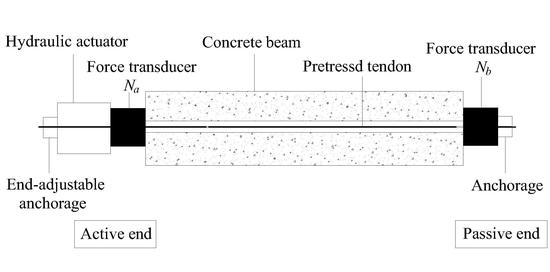Experimental Analysis on Pre-Stress Friction Loss of Crushed Limestone Sand Concrete Beams
Abstract
:1. Introduction
2. Experimental Program
2.1. Theoretical Basis
2.2. Material Properties
2.3. Specimen Fabrication and Testing Technique
3. Test Result and Analysis
3.1. Measured Pre-Stress Loss
3.2. Comparison of Theoretical and Measured Pre-Stress Forces
4. Conclusions
- (1)
- With an increase in the number of tendons, both the total initial tension and friction subsequently increase. The proportion of pre-stress friction loss first increases before decreasing. The pre-stress loss is generally 4–16% in specimens with single-wire, while this is 10–40% in specimens with multi-wire. The friction of inner tendons was shown to form the majority of the instantaneous pre-stress loss.
- (2)
- The friction in specimens with curve duct is definitely larger than that in straight duct. The proportion is 10–30% in curved duct and 10–20% in straight duct. First, large pressure is applied to the curved part. Moreover, the effective length is shortened because the location of tendon changes after tensioning. The curvature effect is the dominant factor in curve duct, which may result in additional friction.
- (3)
- When compared with different duct-forming materials, the pre-stress friction loss in specimens with rubber hose is the largest and reaches nearly 40%. The rubber hose tends to deform and wobble by extrusion, which especially occurs during the concrete pouring. As the contact surface of metal bellow and plastic bellow is smooth, the pre-stress friction loss is smaller. This part of friction loss is mainly determined by the stiffness of duct material and nature of contact surface.
- (4)
- The frictional resistance κ and friction coefficient μ for CLS concrete member with post-tensioning were modified and detailed for each case. The parameters κ and μ are at the ranges of 0.0017–0.007 and 0.108–0.858, respectively. We hope that this work will provide references for the design of pre-stressed concrete structure and engineering applications.
Author Contributions
Acknowledgments
Conflicts of Interest
References
- Mo, Y.; Huang, X.B.; Zeng, Y.S.; Chen, F.H.; He, H.W.; Xiao, L.; Shu, X.J. Research on Key Prestress Construction Techniques of Continuous Box Girder. Adv. Mater. Res. 2013, 724–725, 1670–1676. [Google Scholar] [CrossRef]
- Zhang, Y.; Zheng, Y. Long-Term Deflections of Crushed Limestone Sand Concrete Beams. Adv. Struct. Eng. 2013, 16, 1535–1544. [Google Scholar] [CrossRef]
- Bederina, M.; Makhloufi, Z.; Bounoua, A.; Bouziani, T.; Quéneudec, M. Effect of partial and total replacement of siliceous river sand with limestone crushed sand on the durability of mortars exposed to chemical solutions. Constr. Build. Mater. 2013, 47, 146–158. [Google Scholar] [CrossRef]
- Akrout, K.; Mounanga, P.; Ltifi, M.; Jamaa, N.B. Rheological, Mechanical and Structural Performances of Crushed Limestone Sand Concrete. Int. J. Concr. Struct. Mater. 2010, 4, 97–104. [Google Scholar]
- Cao, Q.; Tao, J.; Ma, Z.J. Prestress loss in externally FRP reinforced self prestressing concrete beams. Constr. Build. Mater. 2015, 101, 667–674. [Google Scholar] [CrossRef]
- Shokoohfar, A.; Rahai, A. Prediction model of long-term prestress loss interaction for prestressed concrete containment vessels. Arch. Civ. Mech. Eng. 2017, 17, 132–144. [Google Scholar] [CrossRef]
- Bai, F.; Davidson, J.S. Composite beam theory for pretensioned concrete structures with solutions to transfer length and immediate prestress losses. Eng. Struct. 2016, 126, 739–758. [Google Scholar] [CrossRef]
- Idriss, R.; Solano, A. Effects of Steam Curing Temperature on Early Prestress Losses in High-Performance Concrete Beams. Transp. Res. Rec. 2002, 1813, 218–228. [Google Scholar] [CrossRef]
- Hurme, S.; Marquis, G. Shear fatigue of the bonded and frictional interface under constant normal pre-stress. Int. J. Fatigue 2015, 70, 1–12. [Google Scholar] [CrossRef]
- Derkowski, W.; Dyba, M. Behaviour of End Zone of Pre-tensioned Concrete Elements. Procedia Eng. 2017, 193, 19–26. [Google Scholar] [CrossRef]
- Markovič, M.; Krauberger, N.; Saje, M.; Planinc, I.; Bratina, S. Non-linear analysis of pre-tensioned concrete planar beams. Eng. Struct. 2013, 46, 279–293. [Google Scholar] [CrossRef]
- García-Segura, T.; Yepes, V.; Dan, M.F.; Yang, D.Y. Lifetime reliability-based optimization of post-tensioned box-girder bridges. Eng. Struct. 2017, 145, 381–391. [Google Scholar] [CrossRef]
- Dang, C.N.; Hale, W.M.; Martí-Vargas, J.R. Assessment of transmission length of prestressing strands according to fib Model Code 2010. Eng. Struct. 2017, 147, 425–433. [Google Scholar] [CrossRef]
- Li, C.; Zhang, K.Y.; Fan, Z.L. Research on Prestressed Loss in Curving Hole of Prestressed Concrete Structure Caused by Frictional Resistance. Appl. Mech. Mater. 2014, 587–589, 1668–1671. [Google Scholar] [CrossRef]
- Yu, T.L.; Zhang, L.Y. Friction Loss of Externally Prestressed Concrete Beams with Carbon Fiber-Reinforced Polymer Tendons. Adv. Mater. Res. 2010, 163–167, 3701–3706. [Google Scholar] [CrossRef]
- Caro, L.A.; Martí-Vargas, J.R.; Serna, P. Prestress losses evaluation in prestressed concrete prismatic specimens. Eng. Struct. 2013, 48, 704–715. [Google Scholar] [CrossRef]
- Hong, S. Effect of Prestress Levels and Jacking Methods on Friction Losses in Curved Prestressed Tendons. Appl. Sci. 2017, 7, 824. [Google Scholar] [CrossRef]
- Shin, K.J.; Kim, Y.Y.; Lee, H.W. Frictional Loss of Prestress Caused by Deflected Tendon. Appl. Mech. Mater. 2014, 513–517, 2599–2602. [Google Scholar] [CrossRef]
- Shin, K.J.; Kim, Y.Y.; Lee, H.W. Frictional Loss of Prestress Caused by Locally Deflected Tendons in Prestressed Concrete Girder Bridges. Adv. Mater. Res. 2015, 1119, 716–720. [Google Scholar] [CrossRef]
- Kim, J.M.; Kim, H.W.; Park, Y.H.; Yang, I.H.; Kim, Y.S. FBG Sensors Encapsulated into 7-Wire Steel Strand for Tension Monitoring of a Prestressing Tendon. Adv. Struct. Eng. 2012, 15, 907–918. [Google Scholar] [CrossRef]
- Xuan, F.Z.; Tang, H.; Tu, S.T. In situ monitoring on prestress losses in the reinforced structure with fiber-optic sensors. Measurement 2009, 42, 107–111. [Google Scholar] [CrossRef]
- Nguyen, K.D.; Kim, J.T. Smart PZT-interface for wireless impedance-based prestress-loss monitoring in tendon-anchorage connection. Smart Struct. Syst. 2012, 9, 489–504. [Google Scholar] [CrossRef]
- Youssef, M.A. Evaluating Prestress Losses during Pre-Tensioning. In Proceedings of the International Construction Specialty Conference, St. John’s, NL, Canada, 27–30 May 2009. [Google Scholar]
- Zhang, K.Y.; Cheng, C. Analysis on Prestress Loss Caused by Friction in Curved Duct in the Design of Prestressed Concrete Structure. In Proceedings of the 4th International Symposium on Lifetime Engineering of Civil Infrastructure, Changsha, China, 26 October 2009. [Google Scholar]
- Guo, Q. Iterative Prediction on Friction Loss Parameters of Prestress Tendon. Appl. Mech. Mater. 2014, 501–504, 1121–1124. [Google Scholar] [CrossRef]
- Wu, X.H.; Lu, X. Tendon Model for Nonlinear Analysis of Prestressed Concrete Structures. J. Struct. Eng. 2001, 127, 96–104. [Google Scholar] [CrossRef]
- Lin, T.Y.; Burns, N.H. Design of Prestressed Concrete Structures; Wiley: Hoboken, NJ, USA, 1981. [Google Scholar]
- Menadi, B.; Kenai, S.; Khatib, J.; Aït-Mokhtar, A. Strength and durability of concrete incorporating crushed limestone sand. Constr. Build. Mater. 2009, 23, 625–633. [Google Scholar] [CrossRef]
- Choi, Y.; Choi, J.H. A Comparative Study of Concretes Containing Crushed Limestone Sand and Natural Sand. Open J. Civ. Eng. 2013, 3, 13–18. [Google Scholar] [CrossRef]
- Singh, B.P.; Yazdani, N.; Ramirez, G. Effect of a Time Dependent Concrete Modulus of Elasticity on Prestress Losses in Bridge Girders. Int. J. Concr. Struct. Mater. 2013, 7, 183–191. [Google Scholar] [CrossRef]


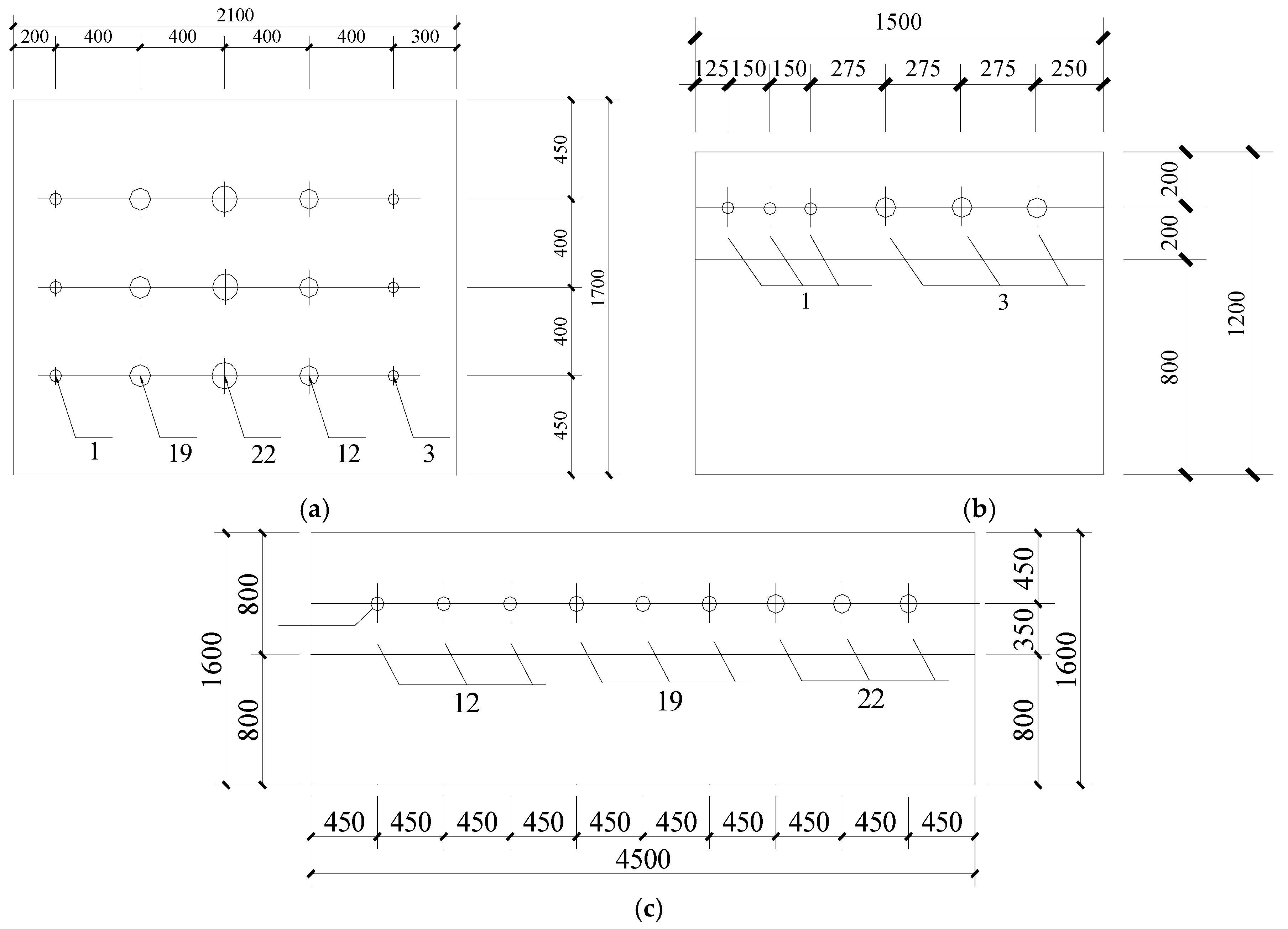


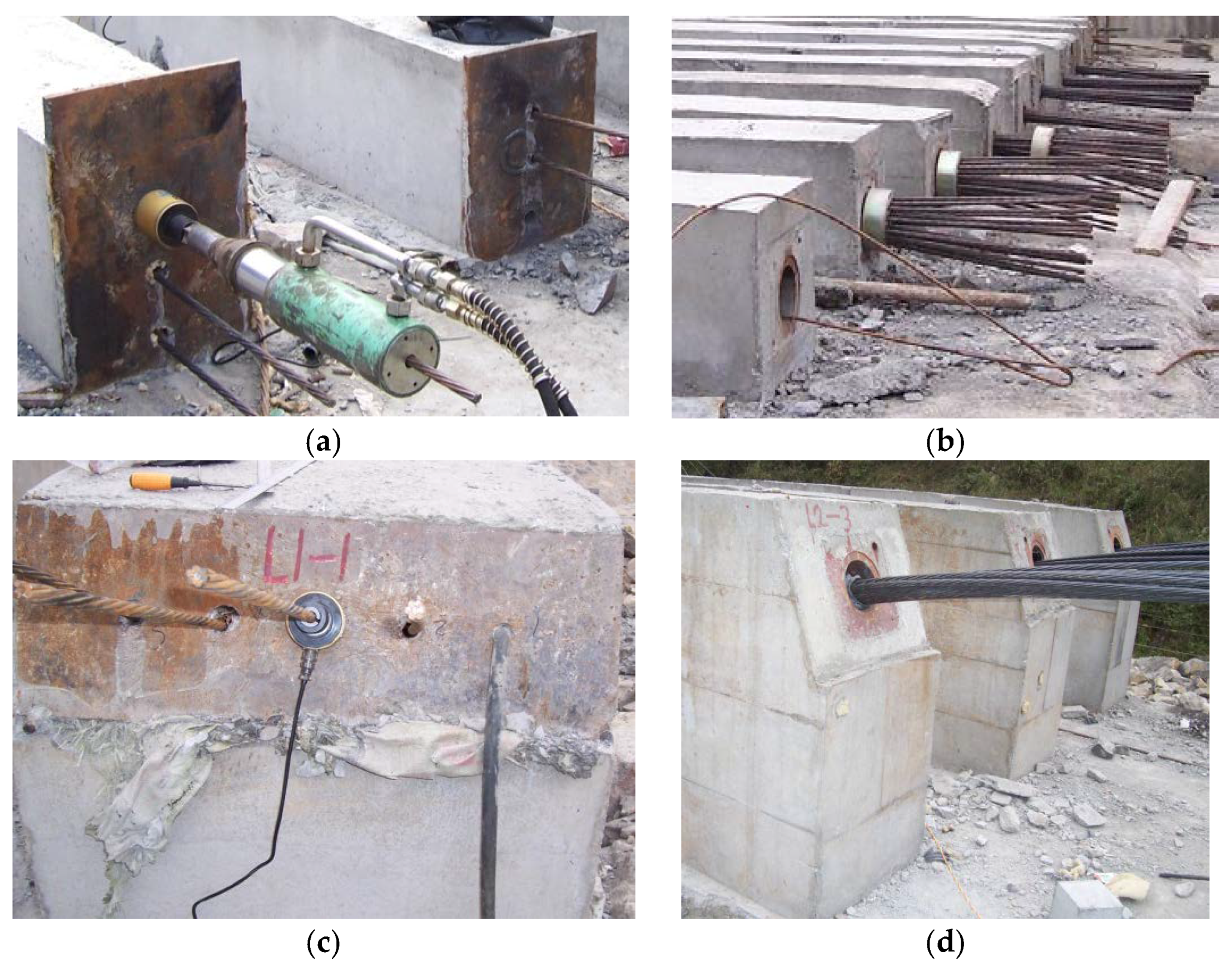

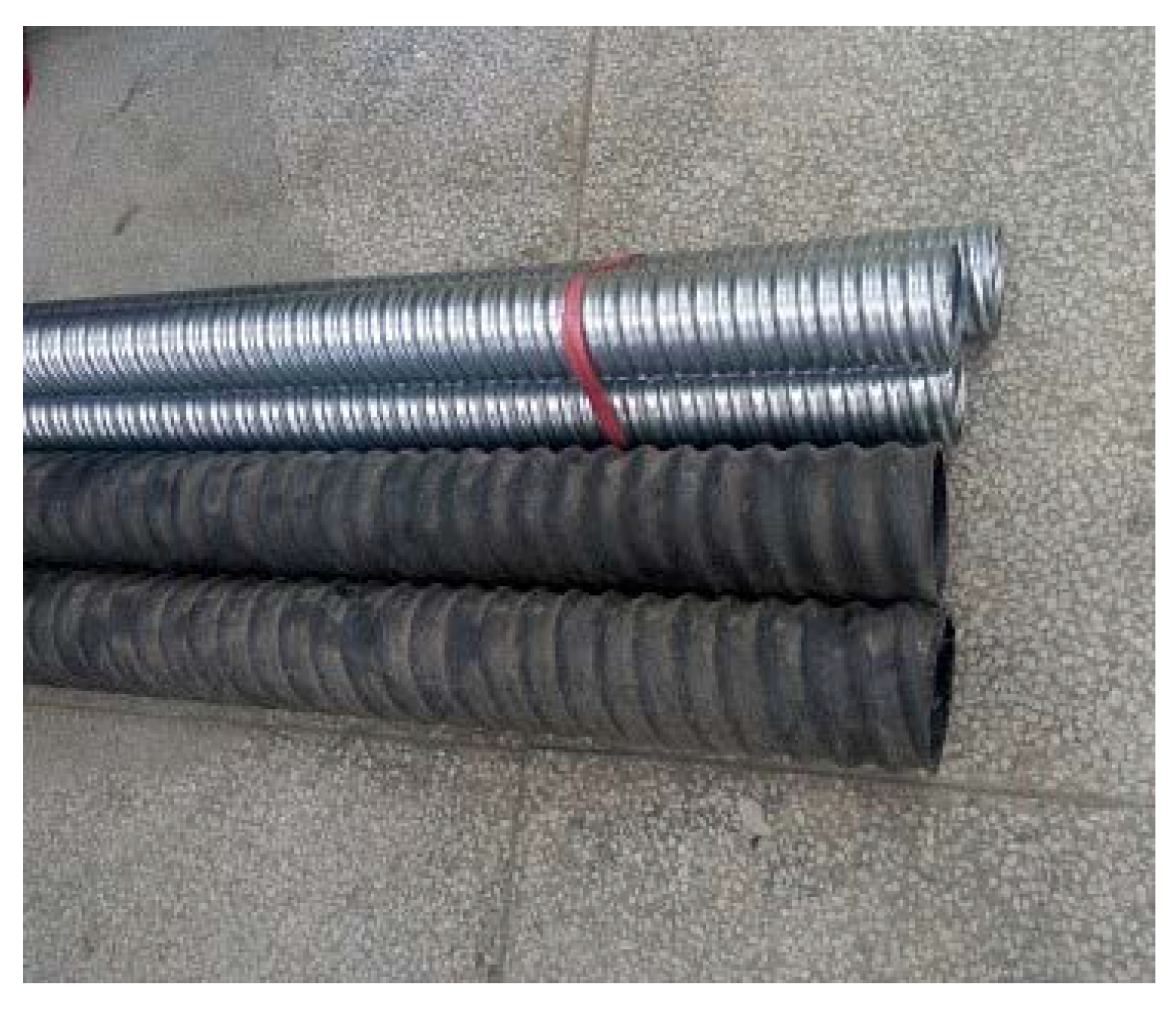
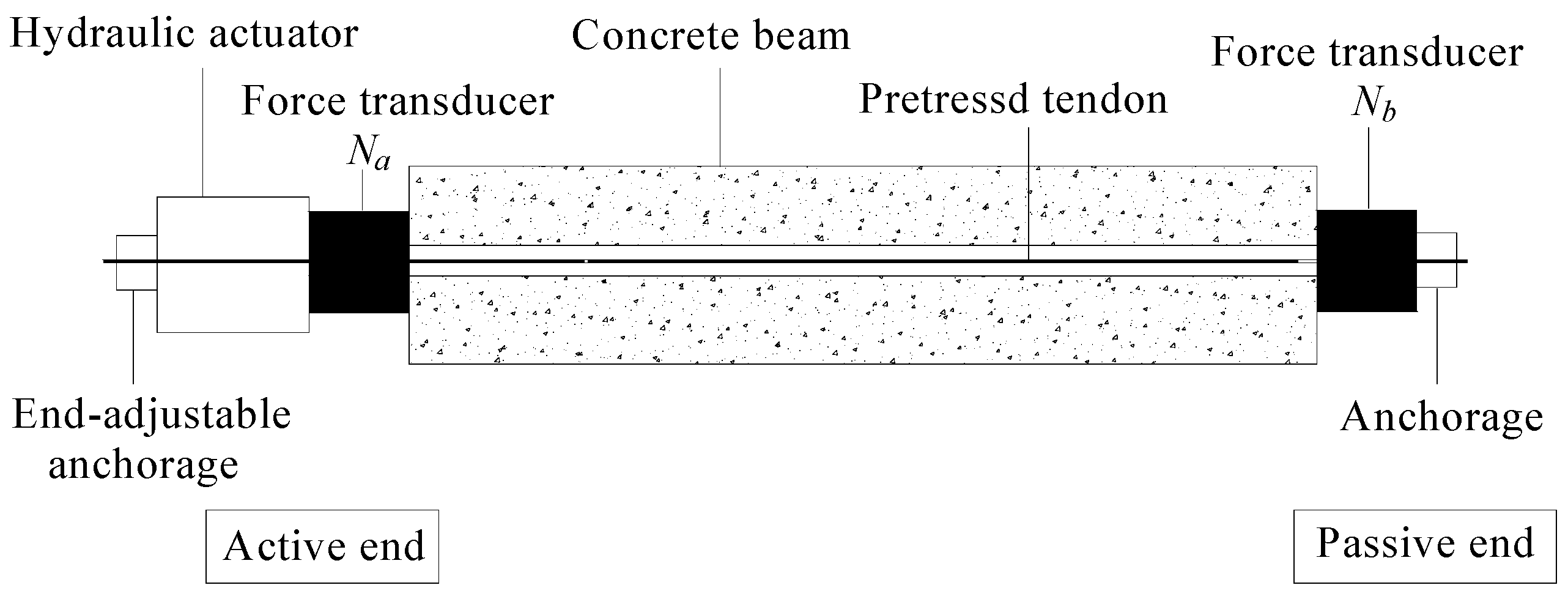



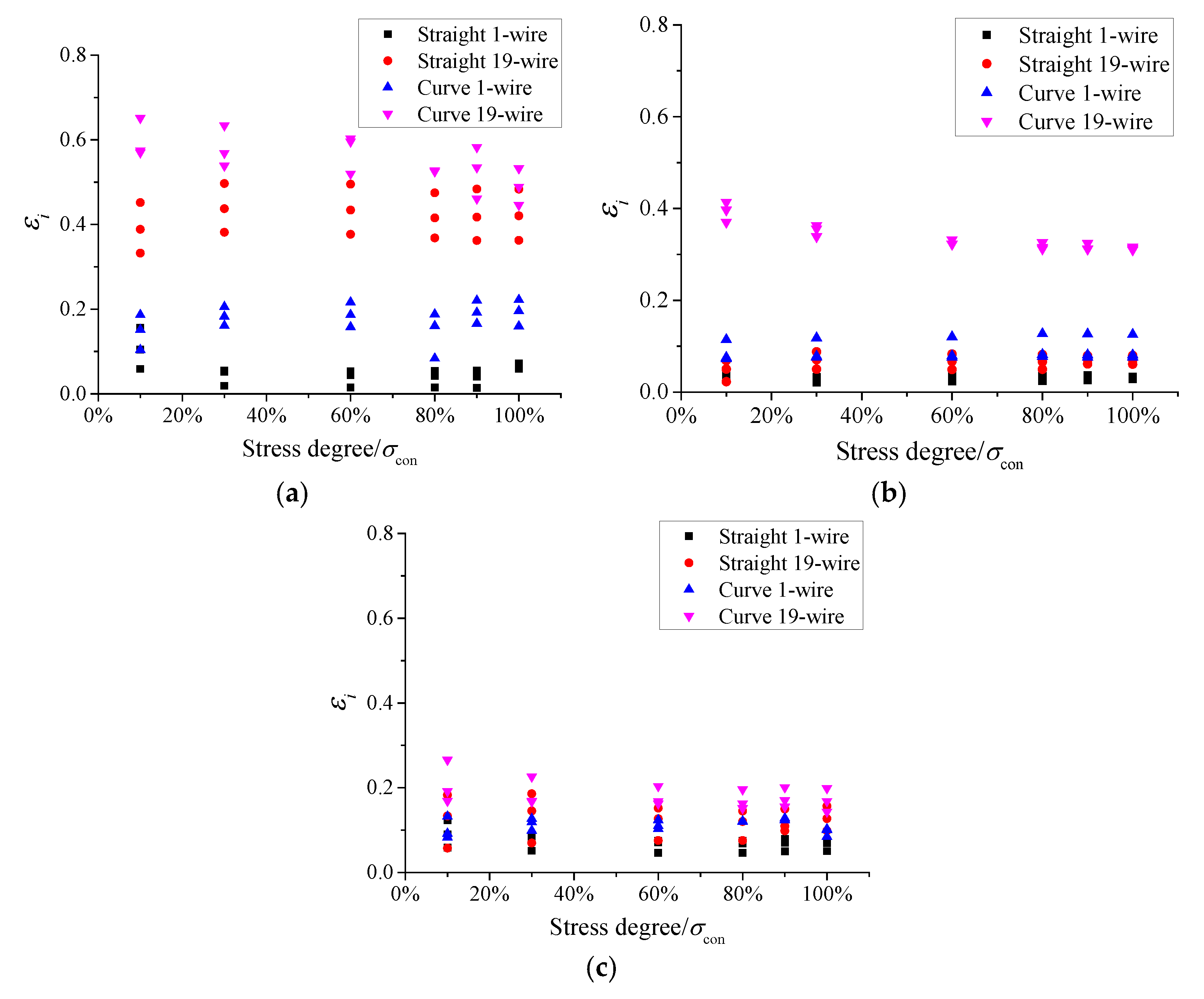
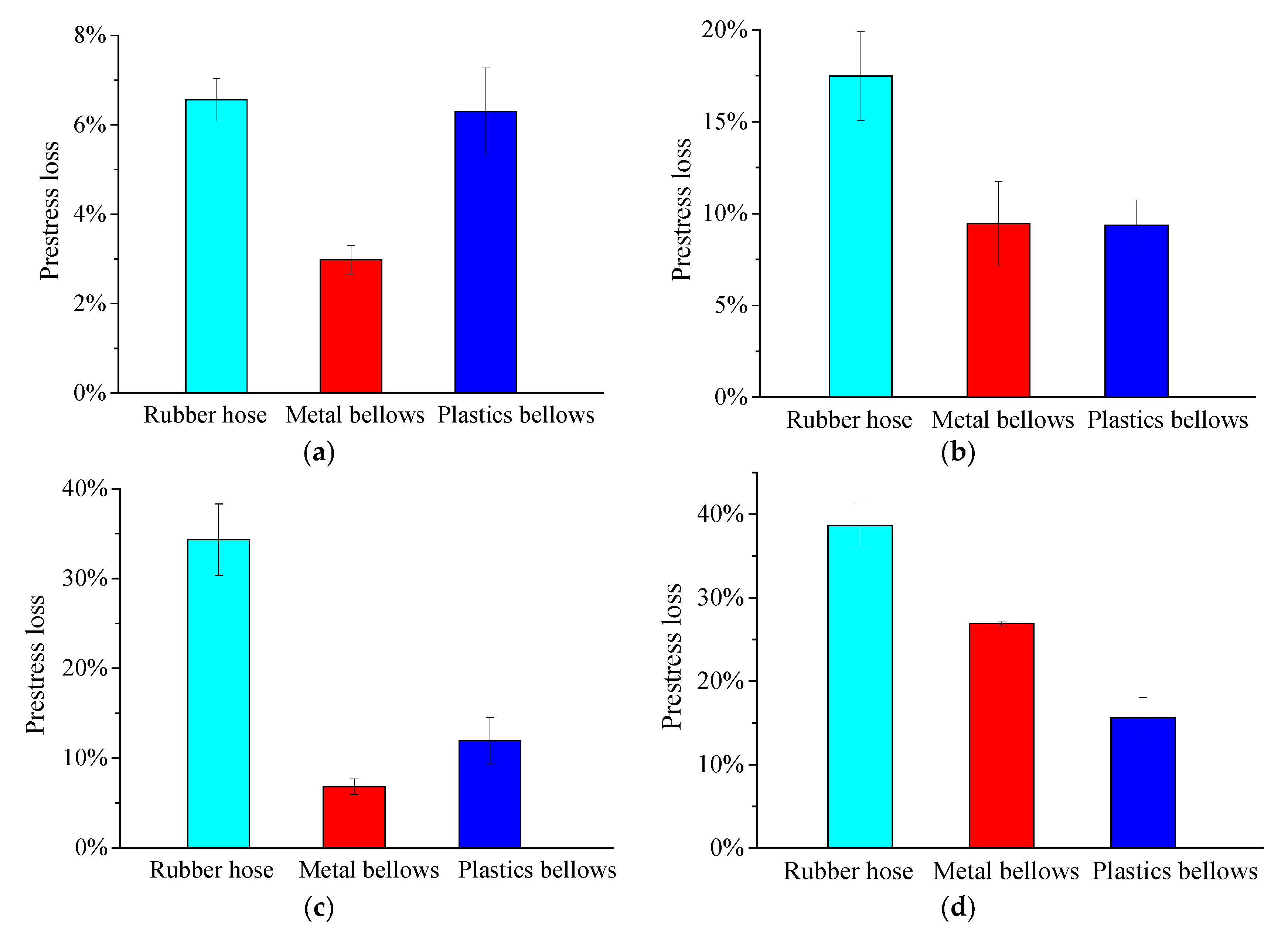
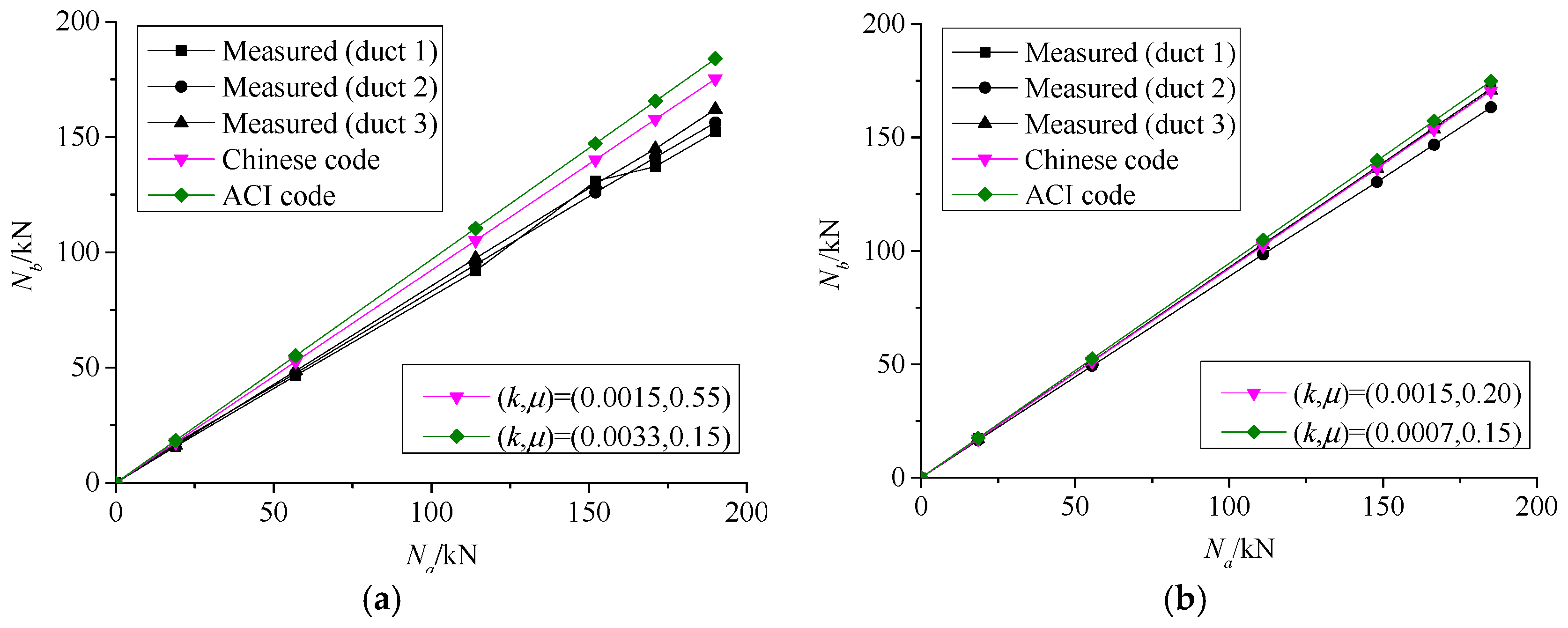
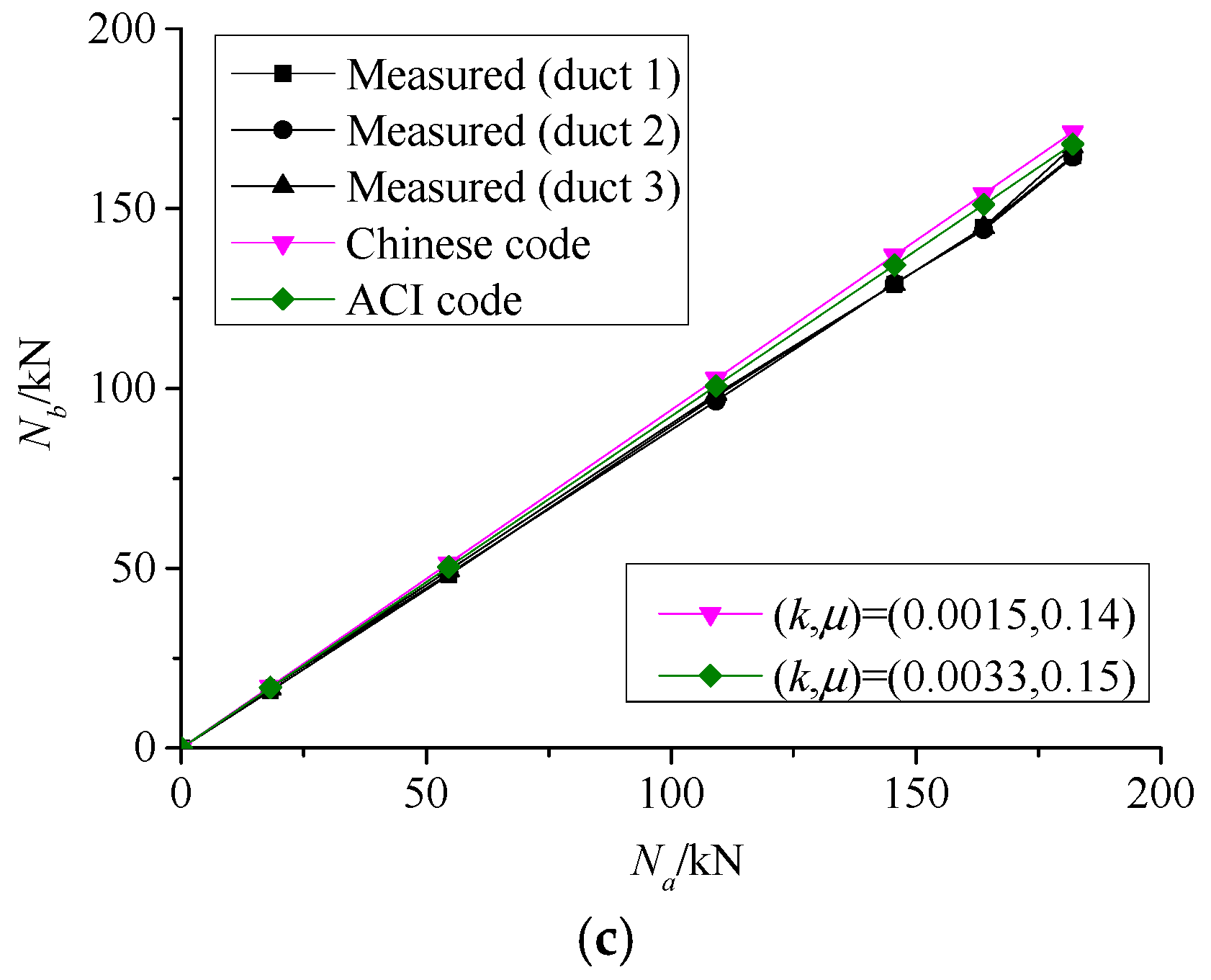

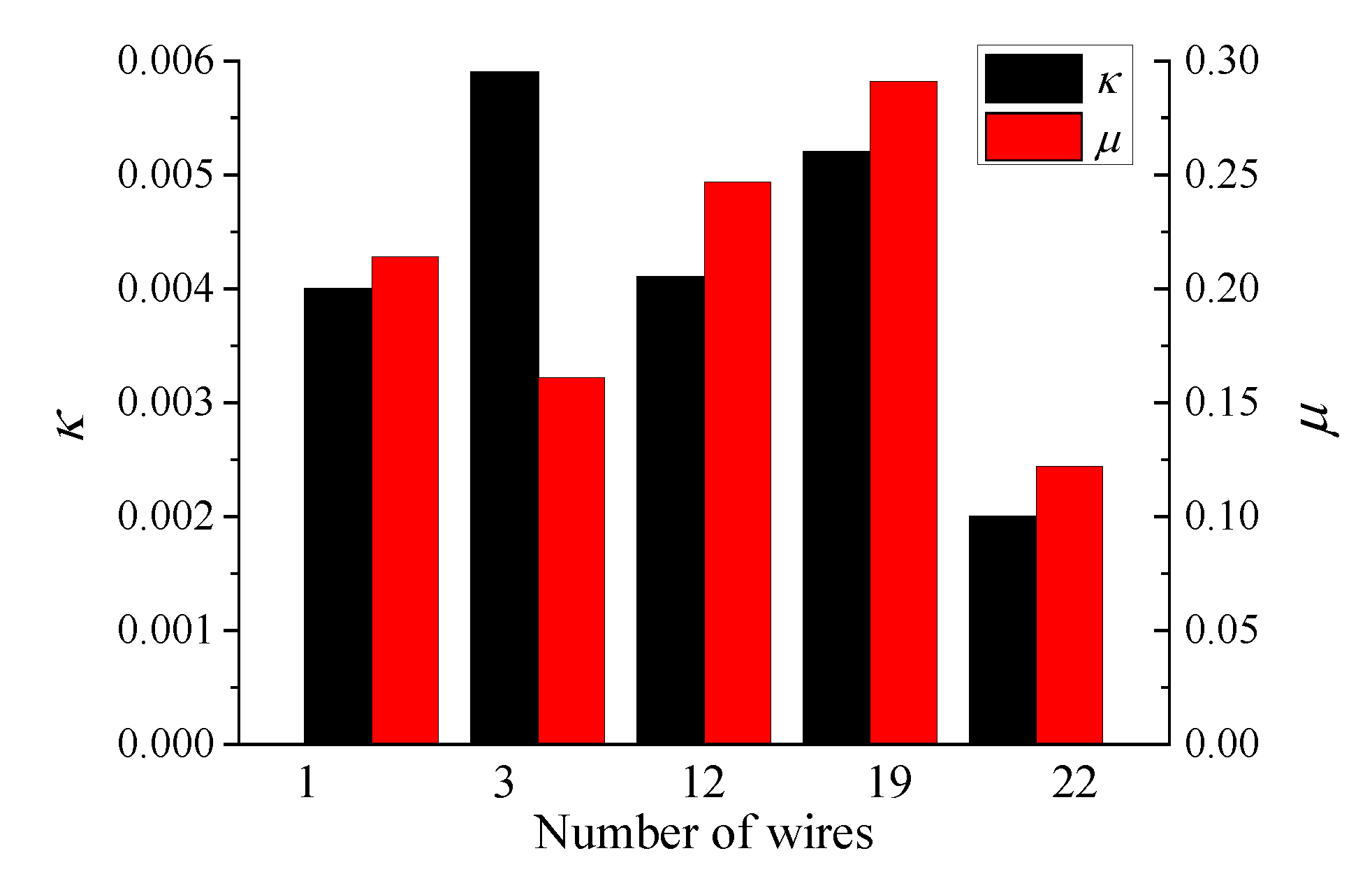
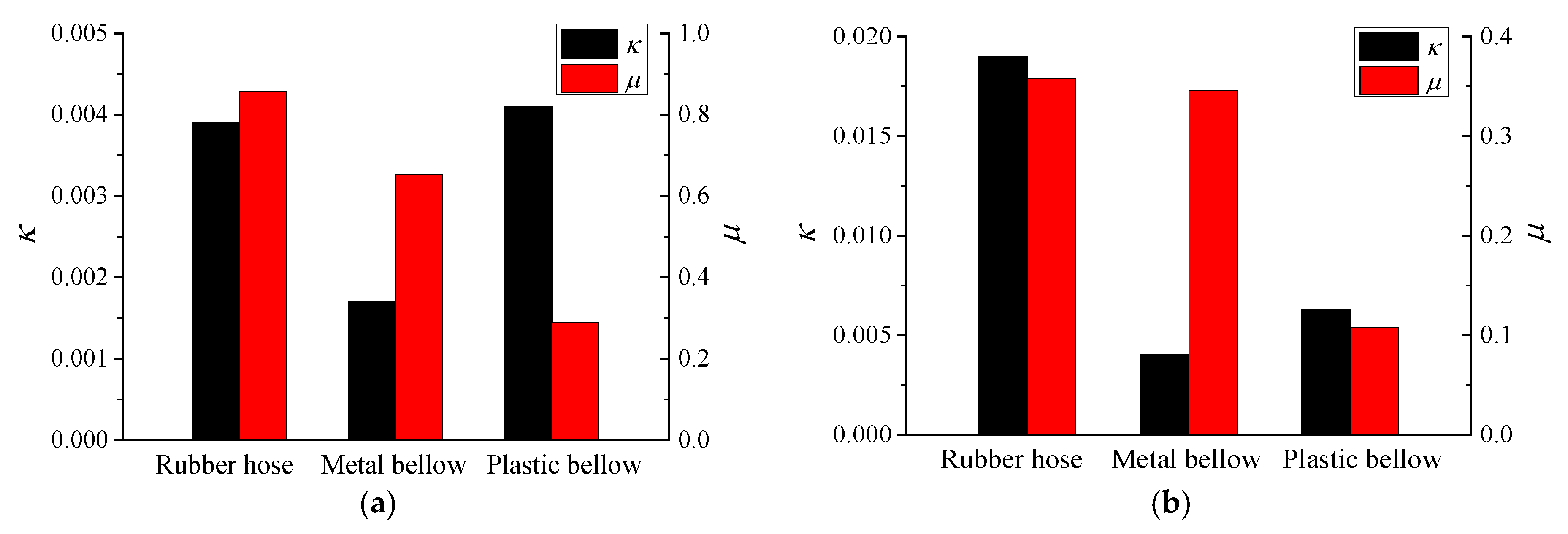
| Material of Duct | κ | μ |
|---|---|---|
| Metal bellow | 0.0015 | 0.200–0.250 |
| Plastic bellow | 0.0015 | 0.140–0.170 |
| Rubber hose | 0.0015 | 0.550 |
| Material of Duct | Type of Tendon | κ | μ |
|---|---|---|---|
| Flexible metal sheathing | Wire tendons | 0.0033–0.0049 | 0.15–0.25 |
| 7-wire strand | 0.0016–0.0066 | 0.15–0.25 | |
| High strength bars | 0.0003–0.0020 | 0.08–0.30 | |
| Rigid metal duct | 7-wire strand | 0.0007 | 0.15–0.25 |
| Cement | CLS | Coarse Aggregate | Water |
|---|---|---|---|
| 458 | 759 | 1048 | 160 |
| Project | Arrangement of Duct | Length/mm | Number of Tendons | Material of Duct |
|---|---|---|---|---|
| Malinghe Bridge | Straight | 15,000 | 1, 3, 12, 19 and 22 wires | Plastic bellow |
| Curve | 9000 | 1, 3, 12, 19 and 22 wires | Plastic bellow | |
| Wujiang Bridge | Straight | 18,000 | 1 and 19 wires | Metal bellow, plastic bellow and rubber hose |
| Curve | 9000 | 1 and 19 wires | Metal bellow, plastic bellow and rubber hose |
| Wires | Straight Tendons | Curve Tendons | ||||
|---|---|---|---|---|---|---|
| Na/kN | Nb/kN | Pre-Stress Loss | Na/kN | Nb/kN | Pre-Stress Loss | |
| 1 | 214.43 | 204.64 | 4.57% | 217.63 | 190.93 | 12.27% |
| 215.26 | 208.25 | 3.26% | 215.36 | 187.11 | 13.12% | |
| 216.29 | 200.82 | 7.15% | 214.02 | 178.76 | 16.48% | |
| 3 | 585.98 | 538.02 | 8.18% | 523.97 | 461.60 | 11.90% |
| 590.98 | 536.36 | 9.24% | 530.58 | 467.45 | 11.90% | |
| 601.00 | 543.80 | 9.52% | 542.98 | 489.98 | 9.76% | |
| 12 | 2327.21 | 2185.95 | 6.07% | 2312.40 | 1835.56 | 20.62% |
| 2348.91 | 2214.88 | 5.71% | 2258.68 | 1846.41 | 18.25% | |
| 2337.23 | 2205.79 | 5.62% | 2300.00 | 1823.87 | 20.70% | |
| 19 | 3705.43 | 3465.15 | 6.48% | 3548.84 | 3256.06 | 8.25% |
| 3713.18 | 3462.12 | 6.76% | 3556.59 | 3265.15 | 8.19% | |
| 3644.96 | 3357.58 | 7.88% | 3499.22 | 3309.09 | 5.43% | |
| 22 | 3996.90 | 3883.33 | 2.84% | 4144.19 | 3650.00 | 11.92% |
| 4043.41 | 3939.39 | 2.57% | 4167.44 | 3757.58 | 9.83% | |
| 4124.03 | 4012.12 | 2.71% | 4192.25 | 3724.24 | 11.16% | |
| Material | Wires | Straight Tendons | Curve Tendons | ||||
|---|---|---|---|---|---|---|---|
| Na/kN | Nb/kN | Pre-Stress Loss | Na/kN | Nb/kN | Pre-Stress Loss | ||
| Rubber hose | 1 | 185.11 | 174.36 | 5.81% | 184.28 | 147.59 | 19.91% |
| 187.71 | 174.88 | 6.84% | 195.72 | 160.93 | 17.78% | ||
| 189.79 | 176.43 | 7.04% | 189.27 | 161.33 | 14.76% | ||
| 19 | 3352.95 | 2067.67 | 38.33% | 3365.08 | 1975.94 | 41.28% | |
| 3444.32 | 2396.99 | 30.41% | 3334.11 | 2045.11 | 38.66% | ||
| 3398.64 | 2232.33 | 34.32% | 3304.68 | 2115.79 | 35.98% | ||
| Metal bellow | 1 | 175.85 | 170.94 | 2.79% | 184.80 | 171.23 | 7.34% |
| 180.01 | 174.88 | 2.85% | 184.48 | 162.73 | 11.75% | ||
| 184.59 | 178.50 | 3.30% | 181.36 | 167.28 | 9.28% | ||
| 19 | 3249.19 | 3057.14 | 5.91% | 3229.05 | 2368.42 | 26.65% | |
| 3346.76 | 3090.23 | 7.67% | 3244.54 | 2363.91 | 27.14% | ||
| 3297.97 | 3073.68 | 6.80% | 3236.80 | 2366.17 | 26.90% | ||
| Plastic bellow | 1 | 185.63 | 172.11 | 7.28% | 182.51 | 165.09 | 9.29% |
| 180.01 | 171.17 | 4.91% | 180.01 | 162.47 | 10.73% | ||
| 184.80 | 172.42 | 6.70% | 182.09 | 167.27 | 8.09% | ||
| 19 | 3142.08 | 2766.92 | 11.94% | 3354.50 | 2906.77 | 13.35% | |
| 3236.55 | 2766.92 | 14.51% | 3334.37 | 2818.05 | 15.48% | ||
| 3199.38 | 2899.25 | 9.38% | 3171.75 | 2600.00 | 18.03% | ||
| Material of Duct | Single-Wire | Multi-Wire | ||
|---|---|---|---|---|
| κ | μ | κ | μ | |
| Metal bellow | 0.0017 | 0.654 | 0.0030 | 0.337 |
| Plastic bellow | 0.0040 | 0.289 | 0.0070 | 0.108 |
| Rubber hose | 0.0039 | 0.858 | 0.0160 | 0.378 |
© 2018 by the authors. Licensee MDPI, Basel, Switzerland. This article is an open access article distributed under the terms and conditions of the Creative Commons Attribution (CC BY) license (http://creativecommons.org/licenses/by/4.0/).
Share and Cite
Xiao, Y.; Zhang, Y.; Lu, J.; Liu, Y.; Cheng, W. Experimental Analysis on Pre-Stress Friction Loss of Crushed Limestone Sand Concrete Beams. Appl. Sci. 2018, 8, 683. https://doi.org/10.3390/app8050683
Xiao Y, Zhang Y, Lu J, Liu Y, Cheng W. Experimental Analysis on Pre-Stress Friction Loss of Crushed Limestone Sand Concrete Beams. Applied Sciences. 2018; 8(5):683. https://doi.org/10.3390/app8050683
Chicago/Turabian StyleXiao, Yunfeng, Yaoting Zhang, Jiezhi Lu, Yong Liu, and Wenjie Cheng. 2018. "Experimental Analysis on Pre-Stress Friction Loss of Crushed Limestone Sand Concrete Beams" Applied Sciences 8, no. 5: 683. https://doi.org/10.3390/app8050683
APA StyleXiao, Y., Zhang, Y., Lu, J., Liu, Y., & Cheng, W. (2018). Experimental Analysis on Pre-Stress Friction Loss of Crushed Limestone Sand Concrete Beams. Applied Sciences, 8(5), 683. https://doi.org/10.3390/app8050683



